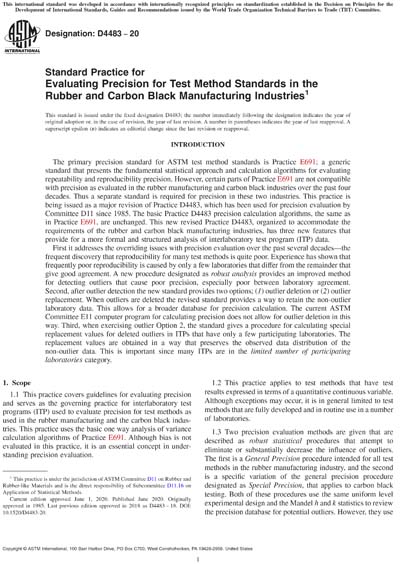Most recent
ASTM D4483-20
Standard Practice for Evaluating Precision for Test Method Standards in the Rubber and Carbon Black Manufacturing Industries
1.1 This practice covers guidelines for evaluating precision and serves as the governing practice for interlaboratory test programs (ITP) used to evaluate precision for test methods as used in the rubber manufacturing and the carbon black industries. This practice uses the basic one way analysis of variance calculation algorithms of Practice E691. Although bias is not evaluated in this practice, it is an essential concept in understanding precision evaluation.
1.2 This practice applies to test methods that have test results expressed in terms of a quantitative continuous variable. Although exceptions may occur, it is in general limited to test methods that are fully developed and in routine use in a number of laboratories.
1.3 Two precision evaluation methods are given that are described as robust statistical procedures that attempt to eliminate or substantially decrease the influence of outliers. The first is a General Precision procedure intended for all test methods in the rubber manufacturing industry, and the second is a specific variation of the general precision procedure designated as Special Precision, that applies to carbon black testing. Both of these procedures use the same uniform level experimental design and the Mandel h and k statistics to review the precision database for potential outliers. However, they use slight modifications in the procedure for rejecting incompatible data values as outliers. The Special Precision procedure is specific as to the number of replicates per database cell or material-laboratory combination.
1.4 This practice is divided into the following sections:
1.5 Six annexes are presented; these serve as supplements to the main body of this practice. Annex A1 and Annex A2 are given mainly as background information that is important for a full understanding of precision evaluation. Annex A3 – Annex A5 contain detailed instructions and procedures needed to perform the operations as called for in various parts of the practice. The use of these annexes in this capacity avoids long sections of involved instruction in the main body of this practice. This allows for a better presentation and understanding of the central concepts involved in the evaluation of precision. Annex A6 is also important; it gives a complete example of precision evaluation that illustrates all of the procedures and options likely to be encountered in any precision evaluation, from the simple to the most complex.
1.6 This standard does not purport to address all of the safety concerns, if any, associated with its use. It is the responsibility of the user of this standard to establish appropriate safety, health, and environmental practices and determine the applicability of regulatory limitations prior to use.
1.7 This international standard was developed in accordance with internationally recognized principles on standardization established in the Decision on Principles for the Development of International Standards, Guides and Recommendations issued by the World Trade Organization Technical Barriers to Trade (TBT) Committee.
ASTM International [astm]

